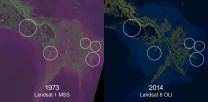When fat is the solution: Using adipose cells to attenuate chagasic cardiomyopathy
2015-08-06
(Press-News.org) Rio de Janeiro -It could be a plot for a vampire story: In the middle of the night, blood-sucking creatures feed on peoples' faces and spread a deadly disease to the hearts of millions, who are then fated to endure a painful death.
Unfortunately, the excerpt is not science fiction, and dramatically illustrates what happens to millions of people who suffer, and eventually die from, chagasic heart failure.
Chagas Disease, also known as American trypanosomiasis, is caused by the parasite Trypanosoma cruzi and is spread by triatomine bugs, also called "kissing bugs". Originally considered a problem of Central and South America, the disease has increasingly been found in other regions, notably in North America, where the immigration of infected individuals has fostered disease transmission by bug-independent forms such as blood transfusion, organ transplantation, and pregnancy. There is no vaccine for Chagas Disease.
Chronic infection with T. cruzi may lead to the cardiac form of the disease, which is its most severe form and affects around 30% of infected patients. Heart failure is a late manifestation of the infection that is often fatal and is thought to result from parasite persistence in the tissues. Antiparasitic drugs are not prescribed to patients with end-stage heart failure, as they are ineffective in such cases.
Approximately 10 years ago, scientists began doing stem cell tests using animal models with the aim of repairing the myocardial damage inflicted by the parasite. Cell therapy has also been tested in patients without success.
Now, a new study done by a consortium of institutions in Brazil, found that in mice, injecting a specific type of adult cell early after T. cruzi infection modifies these animals' response to infection. These mesenchymal stromal cells (MSC) are derived from fat tissue and are specialized in modulating the immune response.
It has been known that the parasite has some preference for the fat tissue, where it can persist for years following the infection. "Mesenchymal stromal cells derived from the fat tissue seemed to us an effective way to put the parasites in close contact with cells that have powerful immunomodulatory effects" says Dr. Adriana Bastos Carvalho, who led the study.
Indeed, the results of the study support the authors' hypothesis, as the mice that received MSCs had fewer parasites in their blood and weaker signs of heart inflammation and fibrosis, which ultimately attenuates myocardial damage.
The next step is to test the same MSCs to treat the hearts of larger infected animals, since a black dagger may work against vampires, but it will certainly have no effect against the deadly bug.
The study entitled "Adipose Tissue-Derived Mesenchymal Stromal Cells Protect Mice Infected with Trypanosoma cruzi from Cardiac Damage through Modulation of Anti-Parasite Immunity " will be published on PLOS Neglected Tropical Diseases on August 6th.
INFORMATION:
ELSE PRESS RELEASES FROM THIS DATE:
2015-08-06
TORONTO - While recently published parenting books have preached the effectiveness of positive parenting and "no drama" discipline, psychologists presenting at the American Psychological Association's 123rd Annual Convention said don't put timeout in timeout yet.
"Parental discipline and positive parenting techniques are often polarized in popular parenting resources and in parenting research conclusions," presenter and researcher Robert Larzelere, PhD, of Oklahoma State University, said at a symposium. "But scientifically supported parenting interventions for young defiant ...
2015-08-06
Rabbits have long been considered immune to prion disease, but recently scientists have shown that they can--under certain circumstances--get transmissible spongiform encephalopathy (or TSE, the scientific term for the fatal brain disease caused by prions). Two studies published on August 6th in PLOS Pathogens address what makes rabbits hard to infect with prions and how their resistance can be overcome.
Prions are misfolded versions of a protein that, in its normal form (called PrPC, encoded by the PRNP gene), is found mainly in nerve cells of all mammals. The misfolded ...
2015-08-06
This news release is available in Japanese.
Today, many wealthy countries are able to mitigate, to some degree, their risk of delta flooding through vulnerability-reducing investments, but a new model suggests that this mitigation may not be sustainable in the long-term. Ultimately, wealthy countries could be feeling the strain of floods to a similar degree as developing countries. To calculate a given delta population's risk of flooding, Zachary Tessler and colleagues accounted for the population's probability of a damage-producing event, how the population's exposure ...
2015-08-06
This news release is available in Japanese.
As a devastating earthquake ruptured Nepal on April 25, 2015, nearby GPS networks continuously recorded measurements at very close distances. In a new study, these data provide the scientific community with unique insights into megathrust earthquakes, which occur when two tectonic plates converge and one plate is forced underneath the other, and may help hazard assessment teams improve earthquake hazard models. To better understand the sudden and intense changes megathrust earthquakes entail, John Galetzka et al. analyzed ...
2015-08-06
This news release is available in Japanese.
In the face of the recent Ebola outbreak, some good news emerges: a preclinical study testing the efficacy of the Ebola vaccine VSV-EBOV against the newly emerged West African Ebola strain shows complete protection when administered seven days before infection in nonhuman primates, and partial protection when administered three days before infection. The positive results of this study further reveal the mechanisms by which an effective immune response is mounted against the Ebola virus, aspects of which have been unclear. ...
2015-08-06
Darwinian selection can be used to evolve robot controllers able to efficiently self-organize their tasks. Taking inspiration from the way in which ants organise their work and divide up tasks, Eliseo Ferrante and colleagues evolved complex robot behaviors using artificial evolution and detailed robotics simulations.
Just like social insects such as ants, bees or termites teams of robots display a self-organized division of labor in which the different robots automatically specialized into carrying out different subtasks in the group, says new research publishing in PLOS ...
2015-08-06
Big data sets are important tools of modern science. Mining for correlations between millions of pieces of information can reveal vital relationships or predict future outcomes, such as risk factors for a disease or structures of new chemical compounds.
These mining operations are not without risk, however. Researchers can have a tough time telling when they have unearthed a nugget of truth, or what amounts to fool's gold: a correlation that seems to have predictive value but actually does not, as it results just from random chance.
A research team that bridges academia ...
2015-08-06
Autopsies of nearly every patient with the lethal neurodegenerative disorder amyotrophic lateral sclerosis (ALS), and many with frontotemporal dementia (FTD), show pathologists telltale clumps of a protein called TDP-43. Now, working with mouse and human cells, Johns Hopkins researchers report they have discovered the normal role of TDP-43 in cells and why its abnormal accumulation may cause disease.
In an article published Aug. 7 in Science, the researchers say TDP-43 is normally responsible for keeping unwanted stretches of the genetic material RNA, called cryptic ...
2015-08-06
For more than 20 years, Caltech geologist Jean-Philippe Avouac has collaborated with the Department of Mines and Geology of Nepal to study the Himalayas--the most active, above-water mountain range on Earth--to learn more about the processes that build mountains and trigger earthquakes. Over that period, he and his colleagues have installed a network of GPS stations in Nepal that allows them to monitor the way Earth's crust moves during and in between earthquakes. So when he heard on April 25 that a magnitude 7.8 earthquake had struck near Gorkha, Nepal, not far from Kathmandu, ...
2015-08-06
Case Western Reserve scientists may have uncovered a molecular mechanism that sets into motion dangerous infection in the feet and hands often occurring with uncontrolled diabetes. It appears that high blood sugar unleashes destructive molecules that interfere with the body's natural infection-control defenses.
The harmful molecules -- dicarbonyls -- are breakdown products of glucose that interfere with infection-controlling antimicrobial peptides known as beta-defensins. The Case Western Reserve team discovered how two dicarbonyls -- methylglyoxal (MGO) and glyoxal (GO) ...
LAST 30 PRESS RELEASES:
[Press-News.org] When fat is the solution: Using adipose cells to attenuate chagasic cardiomyopathy

